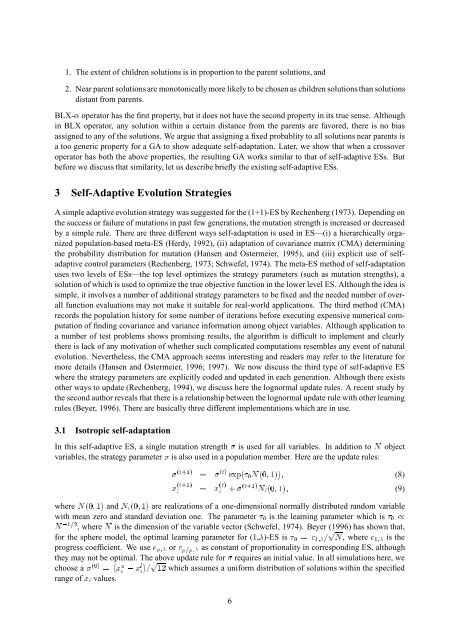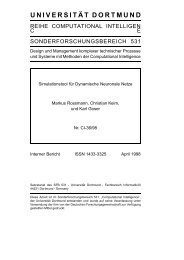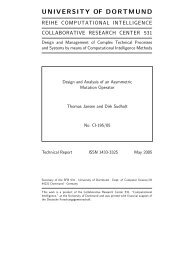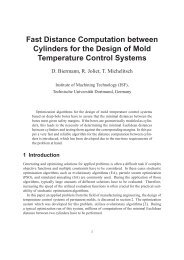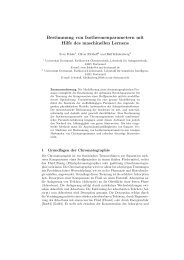Self-Adaptive Genetic Algorithms with Simulated Binary Crossover
Self-Adaptive Genetic Algorithms with Simulated Binary Crossover
Self-Adaptive Genetic Algorithms with Simulated Binary Crossover
Create successful ePaper yourself
Turn your PDF publications into a flip-book with our unique Google optimized e-Paper software.
1. The extent of children solutions is in proportion to the parent solutions, and<br />
2. Near parent solutions are monotonically more likely to be chosen as children solutions than solutions<br />
distant from parents.<br />
BLX- operator has the first property, but it does not have the second property in its true sense. Although<br />
in BLX operator, any solution <strong>with</strong>in a certain distance from the parents are favored, there is no bias<br />
assigned to any of the solutions. We argue that assigning a fixed probablity to all solutions near parents is<br />
a too generic property for a GA to show adequate self-adaptation. Later, we show that when a crossover<br />
operator has both the above properties, the resulting GA works similar to that of self-adaptive ESs. But<br />
before we discuss that similarity, let us describe briefly the existing self-adaptive ESs.<br />
3 <strong>Self</strong>-<strong>Adaptive</strong> Evolution Strategies<br />
A simple adaptive evolution strategy was suggested for the (1+1)-ES by Rechenberg (1973). Depending on<br />
the success or failure of mutations in past few generations, the mutation strength is increased or decreased<br />
by a simple rule. There are three different ways self-adaptation is used in ES—(i) a hierarchically organized<br />
population-based meta-ES (Herdy, 1992), (ii) adaptation of covariance matrix (CMA) determining<br />
the probability distribution for mutation (Hansen and Ostermeier, 1995), and (iii) explicit use of selfadaptive<br />
control parameters (Rechenberg, 1973; Schwefel, 1974). The meta-ES method of self-adaptation<br />
uses two levels of ESs—the top level optimizes the strategy parameters (such as mutation strengths), a<br />
solution of which is used to optimize the true objective function in the lower level ES. Although the idea is<br />
simple, it involves a number of additional strategy parameters to be fixed and the needed number of overall<br />
function evaluations may not make it suitable for real-world applications. The third method (CMA)<br />
records the population history for some number of iterations before executing expensive numerical computation<br />
of finding covariance and variance information among object variables. Although application to<br />
a number of test problems shows promising results, the algorithm is difficult to implement and clearly<br />
there is lack of any motivation of whether such complicated computations resembles any event of natural<br />
x(t+1)<br />
evolution. Nevertheless, the CMA approach<br />
i=x(t) (t+1)=(t)exp(0N(0;1));<br />
seems<br />
i+(t+1)Ni(0;1);<br />
interesting and readers may refer to the literature for<br />
more details (Hansen and Ostermeier, 1996; 1997). We now discuss the third type of self-adaptive ES<br />
where the strategy parameters are explicitly coded and updated in each generation. Although there<br />
is0/<br />
exists<br />
other ways to update (Rechenberg, 1994), we discuss here the lognormal update rules. A recent study by<br />
the second author reveals that there is a relationship between the lognormal update rule <strong>with</strong> other learning<br />
rules (Beyer, 1996). There are basically three different implementations which are in use.<br />
3.1 Isotropic self-adaptation<br />
In this self-adaptive ES, a single mutation strength is used for all variables. In addition toNobject<br />
variables, the strategy parameter is also used in a population member. Here are the update rules:<br />
(8)<br />
(9)<br />
whereN(0;1)andNi(0;1)are realizations of a one-dimensional normally distributed random variable<br />
<strong>with</strong> mean zero and standard deviation one. The parameter0is the learning parameter which N?1=2, whereNis the dimension of the variable vector (Schwefel, 1974). Beyer (1996) has shown that,<br />
for the sphere model, the optimal learning parameter for (1, )-ES is0=c1;=pN, wherec1;is the<br />
progress coefficient. We usec;orc=;as constant of proportionality in corresponding ES, although<br />
they may not be optimal. The above update rule for requires an initial value. In all simulations here, we<br />
choose a(0)=(xui?xli)=p12which assumes a uniform distribution of solutions <strong>with</strong>in the specified<br />
range ofxivalues.<br />
6


